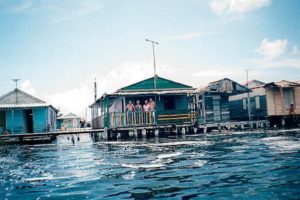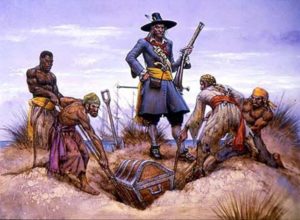 EL TESORO PIRATA ESCONDIDO EN CAYO LA VELA, ISABELA DE SAGUA, CUBA.
EL TESORO PIRATA ESCONDIDO EN CAYO LA VELA, ISABELA DE SAGUA, CUBA.
Al este del poblado de Isabela de Sagua, considerada La Venecia de Cuba, al centro de la isla, se encuentre un pedazo de tierra flotante que está mezclado con leyendas de corsarios y piratas del Siglo XVI, es el llamado “Cayo La Vela”. Según se cuentan, allí llegaban aquellos personajes para esconder sus botines: joyas, lingotes de oro, piedras preciosas… Luego volvían, cuando se habían asegurado que no era peligrosa su ruta marítima, recogían su tesoro y se iban mar adentro.
“La tradición ha afirmado que en el año de 1561 aquí se sepultó un gran tesoro y hasta existía un plano pirata original circulando por las calles de la Villa del Undoso donde se señalaba que la clave del entierro lo eran dos argollas-guías las cuales conducen hasta unas rocas donde una gruesa capa de pintura indica posiblemente) el sitio del tesoro. Pero al parecer este no fue el único entierro y se habla de otras fortunas escondidas en el islote durante los siglos XVI y XVII por El Olonés, Morgan y Pata de Palo”, cuenta Pedro Suárez Tintín en su libro: Los Tesoros de Sabaneque.
Muchos investigadores del finales del siglo XIX afirmaban que Sagua se formó en gran parte con marinos y piratas retirados de la época romántica de los mares caribeños.De ahí que existiera tanto conocimiento del tenebroso pasado de los hermanos de la costa en el pequeño pueblito llamado “El Embarcadero” antes de 1800 (hoy Sagua La Grande).
Los marinos de los primeros tiempos de Sagua le temían a ‘Cayo La Vela’ pues afirmaban que, al pasar cerca de sus costas,sentían almas en pena que los llamaban. Muchos contaron haber recibido descripciones para encontrar antiguos entierros, pero nunca nadie se atrevió a buscarlos. No fue hasta finales del siglo pasado (XIX), durante la Guerra de Independencia cubana que se hicieron algunas excavaciones en el cayo y una verdadera fiebre de tesoros se despertó, pero nunca se supo si el islote premió a algún afortunado. En la actualidad aún se ven las muchas fosas que allí quedaron.
El investigador cubano Salvador Bueno, asegura que los navegantes que se acercaban al lugar también eran testigos de ecos y llamados que los invitaban a desembarcar. “Muchos de ellos, sugestionados por esta idea, encontrándose próximos al cayo, habían oído voces de seres del más allá, que los incitaban a que hicieran excavaciones para que se apoderasen del ansiado tesoro”, cuenta Bueno.
Antes los pobladores de Isabela de Sagua sentían mucho miedo de acercarse al cayo porque precisamente se decía que se escuchaban voces, lamentos y ruidos de cadenas.
En la actualidad, cuentan los que han tenido la valentía de llegar hasta allí, que el lugar está lleno de hoyos, como resultado de las búsquedas, pero aún nadie ha podido encontrar las riquezas supuestamente escondidas en aquel paraje.
Mientras, Cayo La Vela sirve de refugio a pescadores y carboneros que trabajan para ganarse la vida, sin buscar tesoros, ni riquezas fáciles.
 THE PIRATE TREASURE HIDDEN IN CAYO LA VELA, ISABELA DE SAGUA, CUBA.
THE PIRATE TREASURE HIDDEN IN CAYO LA VELA, ISABELA DE SAGUA, CUBA.
To the east of the town of Isabela de Sagua, considered La Venecia de Cuba, in the center of the island, is a piece of floating land that is mixed with corsair and pirate legends of the 16th century, it is called “Cayo La Vela”. As they are told, those characters arrived there to hide their booties: jewels, gold bars, precious stones … Then they returned, when they had made sure that their sea route was not dangerous, they collected their treasure and went offshore.
“Tradition has affirmed that in the year of 1561 a great treasure was buried here and there was even an original pirate plane circulating through the streets of the Villa del Undoso where it was pointed out that the key to the burial was two guide rings which lead to some rocks where a thick layer of paint possibly indicates) the treasure site. But apparently this was not the only burial and there are other fortunes hidden in the islet during the 16th and 17th centuries by El Olonés, Morgan and Pata de Palo, ”says Pedro Suárez Tintín in his book: Los Tesoros de Sabaneque.
Many researchers of the late nineteenth century claimed that Sagua was formed largely with sailors and pirates removed from the romantic era of the Caribbean seas. Hence there was so much knowledge of the dark past of the brothers of the coast in the small town called “ The Embarcadero ”before 1800 (today Sagua La Grande).
The sailors of the early days of Sagua were afraid of ‘Cayo La Vela’ because they claimed that, when they passed near their coasts, they felt souls in pain that they were called. Many said they had received descriptions to find ancient burials, but no one ever dared to look for them. It was not until the end of the last century (XIX), during the Cuban War of Independence that some excavations were made in the key and a real treasure fever woke up, but it was never known if the islet rewarded some lucky person. Today you can still see the many graves that remained there.
The Cuban researcher Salvador Bueno, says that the navigators who approached the place were also witnesses of echoes and calls that invited them to disembark. “Many of them, suggested by this idea, being close to the key, had heard voices of beings from beyond, who encouraged them to do excavations to seize the coveted treasure,” says Bueno.
Before, the inhabitants of Isabela de Sagua were very afraid of approaching the key because it was precisely said that voices, regrets and chain noises were heard.
At present, they have those who have had the courage to get there, that the place is full of holes, as a result of the searches, but still, no one has been able to find the wealth supposedly hidden in that place.
Meanwhile, Cayo La Vela serves as a refuge for fishermen and coal workers who work for a living, without looking for treasures or easy riches.
Agencies/ Wiki/ Radio Enciclop./ Laura Barrera/ Extractos/ Excerpts/ Internet Photos/ Arnoldo Varona/ www.TheCubanHistory.com
THE CUBAN HISTORY, HOLLYWOOD.



 < THE PIRATE Treasure Hidden in "Cayo La Vela", Isabela de Sagua, Cuba.
< THE PIRATE Treasure Hidden in "Cayo La Vela", Isabela de Sagua, Cuba.







